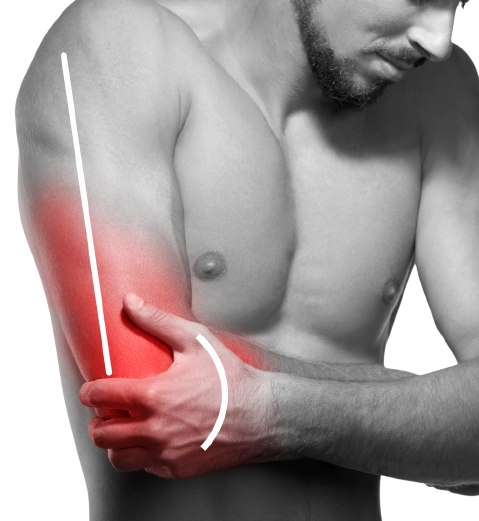Hand & Arm Pain
Hand & Arm Pain
Hand & Arm pain refers to pain that is felt at the wrist or fingers. Further diagnosis generally identifies if the pain is external or internal, leading to treatment. In most situations, any form of hand injury can impede one’s ability to carry out simple tasks. Given the significant use of our hands, hand injuries account for up to one-third of all injuries at work.
What Causes Hand & Arm Pain?
Hand pain can be caused by different reasons. Many local causes of hand conditions are due to inflammation, wear and tear while others may be caused by systemic causes such as referred pain from immunological (e.g., Gout or Rheumatological) or nerve impingement from the neck (i.e. cervical radiculopathy).

Types of Hand & Arm Pain Conditions
Fibromyalgia (Finger)
Fibromyalgia is a hypersensitive neurological syndrome. The central nervous system becomes extremely sensitised and muscles will become spastic and stiff while the surrounding joints in the fingers appear to feel pain. It ‘appears to feel pain’ because there is no inflammation or destruction in the joints. The fingers may feel stiffness in the morning and improves after the body has warmed up.
Rheumatoid Arthritis (Finger)
Rheumatoid Arthritis is an immunological condition affecting all joints of the body. The immune system has become overly sensitised and starts to attack and destroy the joints of the body especially fingers, wrists, elbows, knees and toes. This is not due to wear and tear of degeneration but an innate destruction of the joints resulting in inflammatory arthritis. Morning stiffness and pain is a feature of RA, together with signs of redness, warmth and swelling.
Trigger Finger
Trigger Finger is the locking of the finger joints during flexion or extension of the finger. The condition usually begins with an accompanying ache that is felt in the palm from moving the affected finger. It is estimated that 2 out of 100 people suffer from Trigger Finger, which is more common in women with diabetic conditions aged 40 and above.
Wrist Tenosynovitis
Often described as pain and swelling of the wrist joint, the condition is commonly referred to as “De Quervain’s Tenosynovitis”. The inflamed area is on the wrist area close to the thumb. This is commonly seen in repetitive strain injury when subjecting the wrist tendons to a repetitive motion. Mothers looking after their newborn babies also are susceptible to this repetitive strain injury.
Golfer/Tennis Elbow
As the name suggests, Golfer’s elbow can be a result of the overuse of the elbow in activities such as golf, weightlifting or sports. Alternatively, it can also be caused by ordinary circumstances such as cooking or working on a computer. It is a condition that causes pain anywhere from the forearm to the elbow. Though the condition affects only 1% of the population, it is a condition that is equally likely to affect the older age group. Commonly Tennis Elbow occurs in housewives who succumbed to repetitive strain injuries of household chores such as wringing of clothes, wet towels and washing of windows and walls.
Symptoms Of Hand & Arm Pain
Pain
Stiffness
Tenderness & Swelling
A Message About Hand & Arm Pain
Early diagnosis and treatment are important to the overall recovery of the underlying condition. If there is any delay in treatment, there may be complications such as contractures or nodules formation secondary to persistent inflammation of the tendons and soft tissues. Once they are formed, the chance of recurrence of the underlying condition is higher despite successful treatment of the painful condition. Rehabilitation post-treatment is important and changes in lifestyle will reduce the chance of recurrence.
Diagnosing Hand & Arm Pain
Determining the source of the pain is essential to recommend the right method of treatment and rehabilitation. Here at Singapore Paincare, our team of experienced primary care physicians and paincare specialists will conduct a thorough diagnosis. This includes a physical exam, questions about your symptoms, and an evaluation of your medical history. Other reports may be needed such as an X-ray or an MRI scan to evaluate or confirm the degree of your hand pain.
What Treatments Are Available for Hand & Arm Pain?
Depending on the severity of the shoulder injury, medication or surgery may be required to treat the damaged bone, ligament, or muscles.
Non-Surgical Treatments for Hand & Arm Pain
Conservative treatment of shoulder pain would include rest, support, and ice. Often, simple painkillers such as Panadol or Anti-inflammatory medications can reduce the inflammatory pain of simple injuries and sprains. Some of the treatments for shoulder pain may benefit from physiotherapy, which can help to reduce stiffness in the affected areas and help to accelerate the restoration of rotator cuff function.
When pain has persisted beyond 6 weeks, it would need additional medical attention to assist in the healing of the shoulder pain. Generally, some specialised injections would be needed to help with the healing of painful conditions.
Splinting
Injuries such as trigger finger may require splinting to reduce inflammation and allow for recovery. These splints can be used for a period of six to ten weeks. Wrist splints may be used to support patients with De Quervain’s Tenosynovitis.
Anti-inflammatory drugs
Non-steroidal anti-inflammatory drugs are effective in eliminating the pain caused by arthritis, and can also reduce bruises, fractures, and sprains, but are less effective in tendonitis and carpal tunnel syndrome.
Specialised Injection
Cortisone is a steroid that is used by our doctors to treat inflammation. It is a form of anti-inflammatory which can be used to relieve pain quickly. This simple intervention provides immediate relief without significant risks.
It is advisable to inject only three times a year to prevent tendons and bones from becoming weak. In general, if one should need repeated injections (more than 2 times), further evaluations with MRI investigations may be warranted by our specialists before more injections are administered to the painful area.
Minimally Invasive Treatment
Surgical Treatments for Hand & Arm Pain
Short-term shoulder injuries can be resolved with conservative treatments. However, severe injuries may require surgery, this is usually discussed with our doctors to see if patients are suitable candidates.
If you choose to have surgery, your options may include:
Carpal Tunnel Release Surgery
Trigger Finger Release
How Can I Prevent Hand & Arm Pain?
Wrist pain due to injuries is almost impossible to prevent, but you can minimize the risk by taking the following steps daily:
- A healthy balanced diet that is rich in calcium and vitamin D
- Do some stretching to increase blood flow to the area and improve recovery or the range of motion
- Pay attention to the repetitive movements that may cause the injury and avoid doing it
Get Your Pain Resolved
Send your enquiries or consult our pain experts today.


